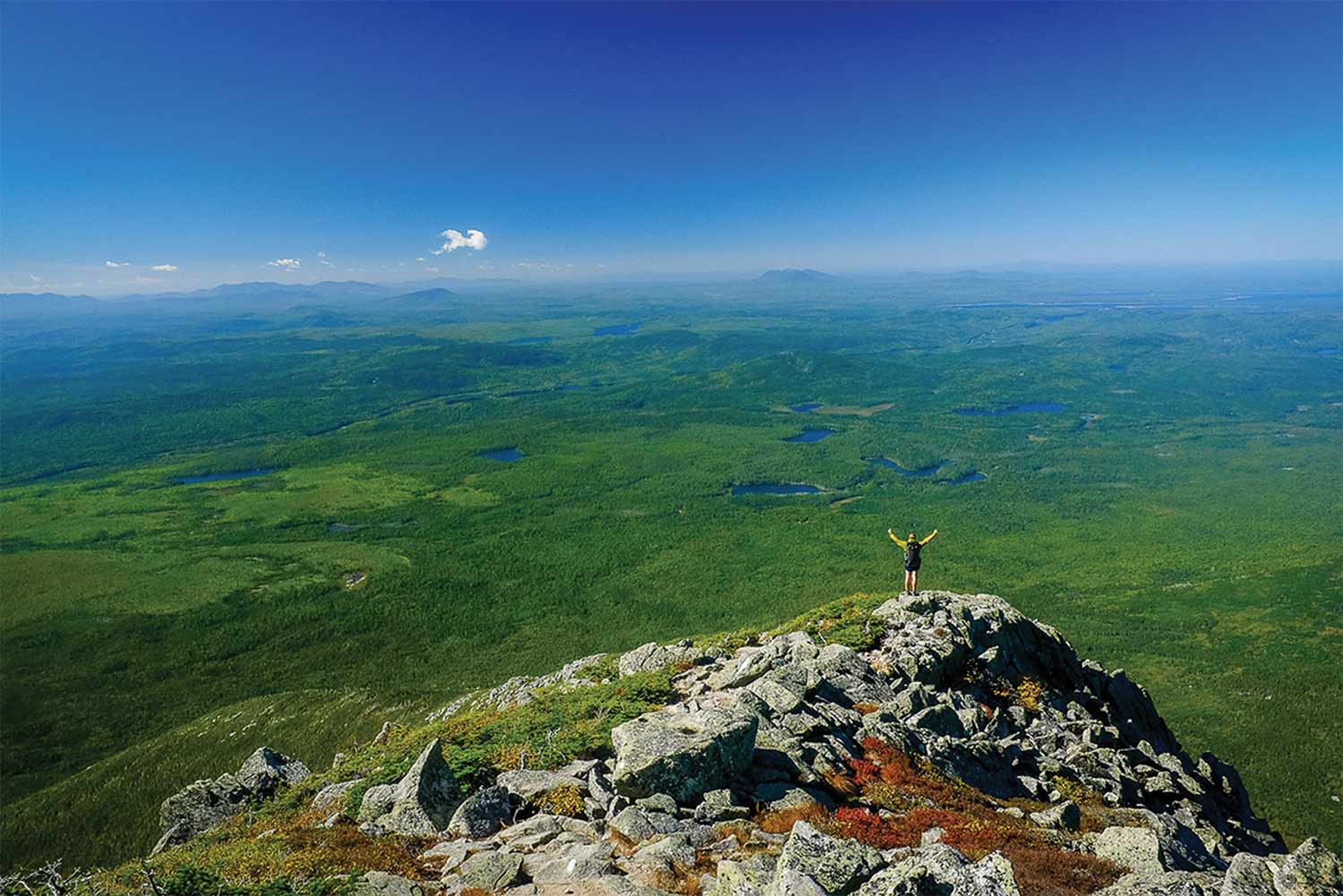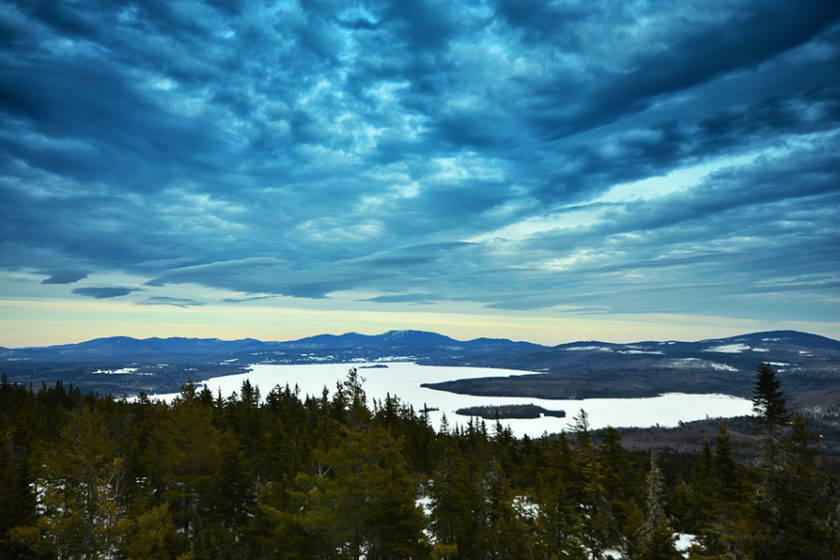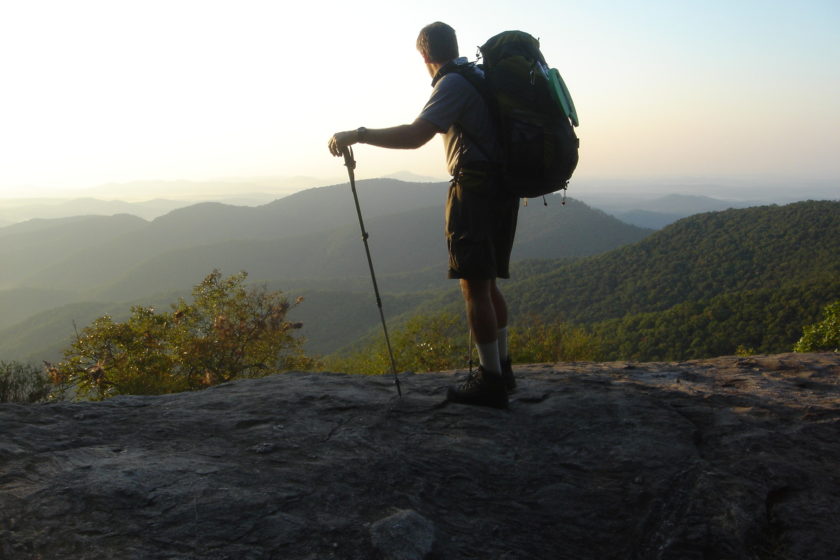By Jennifer Pharr Davis
Scenic Views
Originally published in the Summer 2019 issue of A.T. Journeys Magazine.
I had been on the Trail for a little over four weeks and despite the demanding climb to the summit of Roan Mountain my legs still felt energized. The Trail stretched before me like a moving sidewalk that pulled me forward without effort. It was late April and the breeze brought the stirring scent of spring to the 6,000-foot ridgeline. The eastern horizon was stacked with layers of mountains that turned violet and indigo as the sun grew heavy in the sky. To the west, the deep green of Christmas tree farms and spring flora filling the valley floor. As I ascended Hump Mountain, the sun descended on a distant peak. And, like a lit match to a firework, the sinking orb ignited the sky with rose color hues and golden linings on every cloud.
When I reached the top, I was overtaken with the moment. Without thinking, I shouted, “Praise God,” at the top of my lungs. Suddenly, I felt self-conscious. I looked around again to make sure I was alone. I was… I was by myself, standing on top of a 400-million-year-old mountain, with uninterrupted views in every direction, and the moment was too full to be contained.
For someone else, the expression might have been “Thank you,” or “I’m Free.” Or perhaps the sentiment could be best expressed in a guttural cry, a wolf-like howl or silent tears. But regardless of the expression, the translation is universal. There was something in that place and in that moment, there was something about the undeveloped landscape stretching like fingers in all directions that was transcendent.

George Masa with his camera in the Shining Rock Wilderness, North Carolina. Originally published in the Summer 2019 issue of A.T. Journeys Magazine.
The Appalachian National Scenic Trail is sometimes described as a green tunnel. And, while the details of the bio-diversity and the sanctuary of the forest are identifying characteristics of the footpath, it is the scenic viewpoints that offer respite and release from long stretches within the canopy.
Myron Avery, early pioneer and leader of the Appalachian Trail, once said of the footpath, “It beckons not merely north and south, but upward to the body, mind and soul of man.” And when you hike to scenic vistas such as Hump Mountain, McAfee Knob, Franconia Ridge, and Katahdin you feel exactly what he meant.
In 1968, when the United States Congress recognized the Appalachian Trail as deserving of limited support and protection from the federal government it did not highlight the path’s length, history, or recreation opportunities in the designation. Instead, it acknowledged its aesthetics. The Appalachian National Scenic Trail is a significant title in that it upholds the human need for natural beauty.
The Appalachian National Scenic Trail is a significant title in that it upholds the human need for natural beauty.
Beauty begets beauty — and conservation. The majesty of the Appalachian Mountains has inspired art in many forms, from folk ballads to watercolor paintings, from handmade quilts hung on walls to renowned poetry and reflections recited the world over. Some art, such as the stunning early photographs by George Masa, have also helped to protect and preserve the Appalachian Trail and its surrounding landscape or viewshed.
Masa, a Japanese immigrant who stood no more than five feet tall, used a bike wheel as an odometer to mark and measure the Appalachian Trail along the North Carolina and Tennessee border; and he brought his camera along to capture the stunning vistas of the southern Appalachians. His photographs, along with the writings of Horace Kephart, were a driving factor in the federal designation of the Great Smoky Mountains National Park and in raising the ten million dollars stipulated by Congress to fund the park.
Whereas artists, recreationalists, and government legislation recognize the inspiration of the scenic views of the Appalachian Trail, the land parcels, which stitch together the awe of that place are still susceptible to the pressure of increased development and infrastructure. There is a daily and constant tension to allow for the expansion of a growing population while protecting the scenic vistas that improve quality of life, encourage conservation, and preserve history.

Image by Aaron Ibey. Originally published in the Summer 2019 issue of A.T. Journeys Magazine.
Recently, the Appalachian National Scenic Trail has been listed as eligible for listing on the National Register of Historic Places and the path’s scenic views and overlooks are a primary consideration in the designation. For as much as a historic house might teach us about life in the nineteenth century, think how much more an undisturbed landscape can teach about the history of this place and the men and women who inhabited these mountains over the past 10,000 years. Looking out at the Wild East that remains, and knowing it needs our support, will teach us who we are right now.
I had never experienced beauty like I felt standing on top of Hump Mountain, shouting into the wind, and gazing off into the horizon. But it wasn’t just the beauty of my surroundings that felt divine. It was the realization that I was a part of my surroundings; I was a part of all that beauty. The significance of the scenic views of the Wild East is that they serve not just as a viewpoint into the Appalachians; they serve as a viewpoint into our soul.
 Jennifer Pharr Davis is a hiker, author, and speaker who has hiked more than 14,000 miles and traversed the Appalachian Trail three times. In 2011, she set the overall unofficial speed record on the A.T. (averaging 47 miles per day for 46 days). She has also logged over 600 miles pregnant and over 1,000 miles while nursing. She founded the Blue Ridge Hiking Company — a premier guiding service in the southeastern U.S., which recently launched a lightweight hiking and backpacking boutique in Asheville and a bunkhouse on the A.T. in Hot Springs, North Carolina. “It was a joy to write this piece because the scenic views along the Appalachian Trail are the first place where I felt fully beautiful, self-assured, and a part of the natural environment,” she says. Jennifer is also the author several critically acclaimed books, including Becoming Odyssa and The Pursuit of Endurance.
Jennifer Pharr Davis is a hiker, author, and speaker who has hiked more than 14,000 miles and traversed the Appalachian Trail three times. In 2011, she set the overall unofficial speed record on the A.T. (averaging 47 miles per day for 46 days). She has also logged over 600 miles pregnant and over 1,000 miles while nursing. She founded the Blue Ridge Hiking Company — a premier guiding service in the southeastern U.S., which recently launched a lightweight hiking and backpacking boutique in Asheville and a bunkhouse on the A.T. in Hot Springs, North Carolina. “It was a joy to write this piece because the scenic views along the Appalachian Trail are the first place where I felt fully beautiful, self-assured, and a part of the natural environment,” she says. Jennifer is also the author several critically acclaimed books, including Becoming Odyssa and The Pursuit of Endurance.






